DO-IT News November 2009

Volume 17, Number 2
Below are the articles of the DO-IT News November 2009 newsletter. These articles can also be seen all on one page at the Full Newsletter option.
Director's Digressions
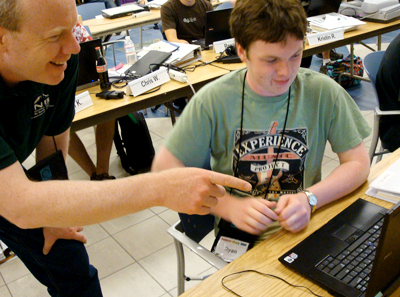
After the completion of another successful and exciting DO-IT Summer Study session (our seventeenth!) and other summer activities, you might wonder what else we do at DO-IT. In addition to supporting DO-IT Scholars and AccessSTEM and AccessComputing team members, we have other projects that keep us busy year-round. I'll highlight one of our latest projects below; details about others can be found on DO-IT's website at www.uw.edu/doit.
DO-IT's innovative RDE Collaborative Dissemination Project was recently funded by the Research in Disabilities Education (RDE) program of the National Science Foundation (NSF) (award # HRD-0929006). In this project we are engaging with all RDE-funded projects to create and disseminate resources. Project partners will use web, print, and video to facilitate effective collaboration. We are excited to begin this new collaboration with other projects around the country. Our joint efforts will, ultimately, increase the success of students with disabilities in science, technology, engineering, and mathematics (STEM) fields!
2009 DO-IT Trailblazers
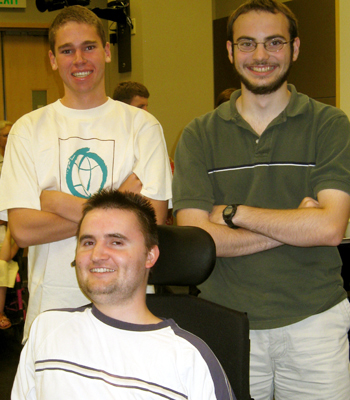
DO-IT Trailblazer awards highlight DO-IT community members who forge new pathways that will benefit others. We select individuals who, through their work and accomplishments, have changed the way the world views people with disabilities and have increased their potential to succeed in college, careers, and community life. Congratulations to this year's honorees!
Kim Borowicz, disability rights lawyer at Access Living and DO-IT Mentor, for contributions on a national level to the field of disability law and a commitment to tackling issues of access to transportation, media, and education for people with disabilities.
Loren Mikola, disability inclusion program manager at Microsoft and AccessSTEM team member, for contributions in making Microsoft an inclusive environment for employees with a wide variety of abilities and disabilities and for promoting the design of accessible technology.
Kris Rosenberg, DO-IT Ambassador and '94 Scholar, for contributing to the long-term success of DO-IT's college preview and technology program at Camp Courage by volunteering his time to provide lab set-up, technology support, instruction, and mentoring.
Jessie Sandoval, DO-IT Ambassador and '98 Scholar, for academic achievement and pursuit of a career in disability law.
Chris Schlechty, DO-IT Ambassador and '02 Scholar, for academic achievement, pursuit of a career in computing, and mentoring interns with disabilities nationwide in the workplace.
Summer Study '09: What Do the Phase I Scholars Do?
The DO-IT Scholars program started in 1993 as an experimental project for teens with disabilities nationwide. It is open to Washington State teens and is supported by the State of Washington, the Boeing Company, and the Microsoft Corporation.
DO-IT Phase I Scholars participate in a two-week, live-in Summer Study session on the University of Washington campus in Seattle. They learn about college life; explore the Internet; interact with peers, staff, and mentors; and have fun.
A Trip to University Village: A Lesson in Access for Wheelchair Users
"I almost died going down that hill," recalled Melissa, a DO-IT Summer Study Intern, regarding the trip to the University Village shopping center. Melissa uses a wheelchair to get around. The sidewalk was wide enough for wheelchairs, but it surely wasn't safe. One of the biggest problems with the sidewalk was that it was bumpy and uneven, making it hard for wheelchairs to move safely down it. Not only was it hard for those in a wheelchair, but also for those who are visually impaired or blind, or others who were just walking. There were so many cracks, divots, and uneven places in the ground that it sent many of us tripping and falling.
As we made it down the hill towards the crosswalk near the curb of the intersection, all limbs surprisingly still intact, we came to find that there was no wheelchair ramp to cross the street. When we finally arrived at University Village, we found that most stores did not have wide enough areas between displays and shelves for wheelchairs. Additionally, almost none of the stores had automatic doors.
What we learned from this trip is, even though it has been almost twenty years since the Americans with Disabilities Act was passed, we have a long way to go to ensure that everything is accessible to wheelchair-users.
Microsoft Field Trip
Our trip to Microsoft was one to remember. My first memory of it is that the building had air-conditioning. With Seattle temperatures breaking heat records it was nice to be in a room that didn't feel like a sauna.
Besides getting a chance to cool off, the best part of the trip was learning about the benefits of internships and how they can help students starting out in their career. We also got to visit a room where Microsoft has accommodations for people with disabilities. They had offices that were built for people with disabilities, including blindness, quadriplegia, and learning disabilities. We were able to see the technology that Microsoft provides to level the playing field for people of different abilities.
The speakers at Microsoft were all people with disabilities, which demonstrated that people with disabilities can get meaningful jobs in the computer science field.
Our trip ended with a visit to the employee store. DO-IT participants received exclusive access to shop for Microsoft products, at employee prices. There were things from games to Windows platforms, all at extremely low prices. This Microsoft trip was not only fun, but also educational for DO-IT Scholars. We would love to do it again.
Wheelchair Rugby
When we first heard the words "wheelchair rugby," we wondered how it worked, because rugby has a lot of tackling, pitching, and kicking. However, when we watched the game we realized that it was a mix of a few different sports: basketball, rugby, and hockey.
Wheelchair rugby is played on a standard basketball court. The objective is to get the entire wheelchair, with complete possession of the ball, over the goal line (much like in hockey). Players are allowed to pass the ball to other players on their team, even if it is a forward pass (much like in basketball). Each team must score within forty seconds of when they gain possession of the ball. They can hold the ball for up to ten seconds before they have to either dribble the ball or pass it to a teammate. If they do not pass the ball or dribble it within the allotted time, the other team gets the ball. Only three people can be in the key at one time, and no one player can stay in the key for more than ten seconds. If an offensive player commits this or any other penalty, then they lose possession of the ball. However, if a defensive player commits the penalty, then a point could be awarded to the opposing team or they could get thrown in the penalty box (much like in hockey). A player only has twelve seconds to advance the ball past half court.
The game consists of four, eight-minute periods with each team allotted six time-outs in regulation. If the game goes into overtime, each team gets an additional time-out. The overtime periods are three minutes each and cannot end in a tie, so one game could go on forever, but it would be unlikely to happen.
We had the opportunity to watch the game in action. It was between two teams: a red team and a black team. The red team used a lot of strategy, communication, and passing, while the black team tried to win using speed and brute strength. Complete opposites were chosen to compete against each other. Despite the speed and strength of the black team, the red team was able to keep the game close for the full thirty-two minutes. In the first period, the black team got out to an early lead by beating up the red team and just blowing past them, but the red team was able to come back and tie up the game before the first period was over. At the start of the second period, the black team again came out strong and took the lead. They were able to maintain their lead throughout the period this time, and had momentum going into the half with a two-point lead.
The start of the second half did not look too bright for the red team, but the start is not the part of the game that matters. The red team was able to fight and climb their way back to a fresh game by the end of the third period, as the score was now tied. As the final period started, it was anybody's game. With the red team's strategy and the black team's brute strength and speed, who would arise as the victor? The score was going back and forth throughout the final period; the suspense was incredible right up until the final buzzer sounded. There were only two goals separating the two teams by the end of the game, and it turns out that brains overpowered brawn. That made us happy, because we were rooting for the red team during the match. A game of wheelchair rugby is an experience that you have to see in person!
Pacific Science Center
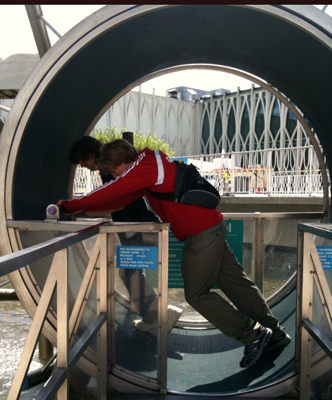
On Saturday, July 18th, the Phase I DO-IT Scholars and Interns traveled to the Pacific Science Center, located in the scenic Seattle Center. After arriving early and getting situated at the unique multi-structured building, we were free to travel throughout the exhibits in small groups, exploring at our leisure.
Between our arrival and lunch, we entered the dinosaur exhibit, which features many life-size models and hands-on activities. Next, we traveled to the bug exhibit, right in time to handle live Madagascar Hissing Cockroaches and listened to a cockroach lecture. After that, we passed through the butterfly house, exploring numerous rare butterflies and the habitats in which they live. Following that, our group went to the Shadow House, a unique exhibit where a shadow of an image is shown on the wall. Next, we traveled to the exhibits that contained live animals, from naked mole rats to large snakes. After that, we toured the gift shop, wrapped up our exploration through the exhibits, and headed outside to a large, open courtyard where the whole group met and had lunch, which also provided a good time for socialization.
When lunch was through, we traveled to the Boeing IMAX Theater to watch Transformers: Revenge of the Fallen. The movie turned out to be action packed, and it was enjoyed by many of the Scholars and staff alike. The IMAX provided a brilliant picture and invigorating surround sound, which completed the movie experience. Following the exciting film, we traveled to the Adobe Laser House to view a unique Beatles Laser Show, which played classic Beatles songs, accompanied by a rhythmic laser show, adding a visual to the classic music. Following the show, we left for the busses and came back to the University of Washington. Wow! What a great day.
Outdoors for All
For two hours on a temperate evening, DO-IT Scholars and Interns cut figure eights in a parking lot and raced each other on a nearby bike trail. Outdoors For All had come to the University of Washington for DO-IT's Summer Study!
Outdoors For All brought a truck full of bikes, both regular and adaptive, types that some Scholars had never seen before. There were ten-gear mountain tricycles, tricycles with wide seats, hand-operated tricycles, bikes with chair-backed seats, pedals designed for extra safety with straps, and other variations. One bike was set up so that it would not coast under any circumstances. One of the most interesting bikes was a two-seater that was pedaled with the riders legs positioned nearly straight out, and steered by handles and handbrakes located beneath the seat. One Scholar who is blind, rode that bike and she really enjoyed it. We all appreciated the diversity of the bikes, which allowed everyone to participate, no matter the nature of their disability.
The evening air rushing by us as we pedaled around the UW was most enjoyable!
Summer Study '09: What Do the Phase II Scholars Do?
Phase II Scholars return to the University of Washington campus for their second Summer Study. They meet the Phase I Scholars, learn about college life and career preparation, and participate in a one-week workshop with postsecondary instructors.
NOAA
The DO-IT Phase II Scholars in the NOAA workshop looked at modern issues confronting the world, as well as environmental issues and solutions. NOAA, the National Oceanic and Atmospheric Administration, is a government organization that focuses on understanding our planet. NOAA studies the big and small, from waterways to global warming. The participants were Phase II Scholars Yomara, Russell, Chris, Nate, and Erik.
We started out with a presentation from Kevin about the bleak story of Easter Island, the most isolated island in the world. From there we discussed various issues, such as global warming both past and present, along with the history of past cultures. Attributes of past cultures and global events that we examined included the Roman Empire with the aqueducts, Mayan Empire as the example of society collapsing, World War I, and the possible war over resources to show the effects of low resources.
From Kelly McCusker and Reid Wolcott, we learned about weather and climate change, as well as some of the career opportunities within the field. Led by Annemarie Poginy, we worked together as a group to develop a presentation for Summer Study's closing ceremonies. Studying environmental issues was both enlightening and terrifying. Today we struggle with our resources, but tomorrow they might be gone.
Neurobiology: Bugs, Mice, and Brains
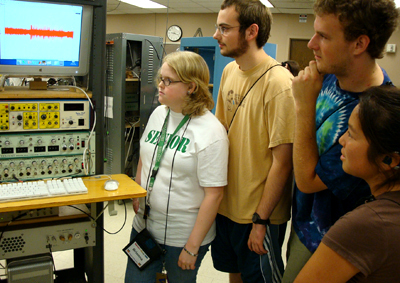
In this Phase II workshop, six Scholars (Erica, Collin, Marco, Aaron, Brianna, and Jeremy) and I got the opportunity to explore neurobiology. Over the course of five days we participated in hands-on experiments that involved mice and cockroaches.
In the mouse lab we examined embryo hind brains. The microscope used both UV lights and white light, which allowed us to see the florescent molecules. Using a computer, we recorded the reaction seen through the microscope. Then we analyzed them and made a movie from the results. We also conducted a pharmacologic test using valproic acid, an anti-seizure medication.
The second lab included testing cockroach legs. The goal was to test different leg spines and see how many neurons were triggered when the spine was poked. We created our own stimulus and tested our hypotheses. We then analyzed our data by finding the rate, mapping how many big and small graph spikes there were, and understanding the graph itself.
Over the five days of the workshop, we had the opportunity to do two college planned labs and use the equipment that college students use. At the end of the five days, we put together a presentation summarizing what we learned. The workshop would not have been possible without Marti, Bill, Stephanie, Hiro, and Deva. Thank you all for your hard work!
Second Life
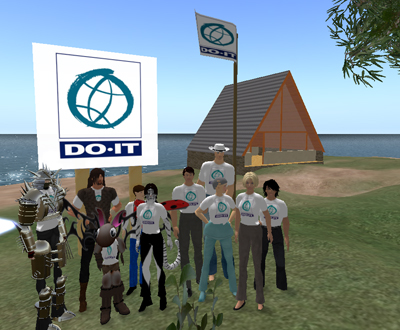
As Interns at DO-IT Summer Study, we got to participate in the workshop "DO-IT Second Life." This workshop focused around the computer program Second Life. In Second Life, users create an avatar that lives in a virtual world and interacts with other people. It is almost like a 3-D chat room. You can fully customize your avatar to look like anything, from a businessman to a celebrity. The choices are endless. You can also build objects like houses, teleport, fly, and chat with other avatars or people you know, in real time.
There are a lot of fun destinations that users can travel to in the game, from research places like the NOAA Research Center, to a medical school in London. While this game was fun, there were times when we needed to log out and log back into the game, in order to fix a problem. It was also very hard to build a good project without having to edit it many times. Despite this, one of the many advantages to the game was the benefit of having access to a number of different places. Second Life is an interesting concept, which can be enjoyed by many.
The Phase II Scholars in this workshop included Sam, Stefani, Christine, Carolyn, and Shelby. Two DO-IT Ambassadors, Scott and Noah gave presentations at this workshop. Being an Intern in the Summer Study program was a fun experience.
DO-IT Students Complete Engineering Labs At the University of Washington
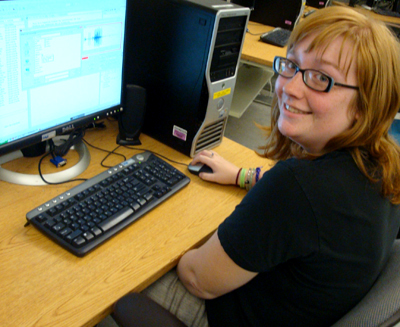
On a Saturday in September, seven students with disabilities came to the University of Washington to work in labs hosted by the College of Engineering. The five high school and two college students met with graduate students and the associate dean to learn about different kinds of engineering. Then they took a quick quiz to test their knowledge about general engineering. After the information session, students split into two groups to complete one of two laboratory experiments.
The "Sounds You Can See" lab allowed the students to work on powerful data crunching computers in the electrical engineering department. The students learned how computers process sound and how to recognize patterns in sounds displayed as visual graphs. Students manipulated different sounds to create unique sound bites.
The "Understanding Robot Movement" lab allowed students to upload data to underwater robots and observe their movements. The students learned how aquatic creatures move through three dimensional space—with the help of a computer! Check the UW College of Engineering website to see their upcoming events (www.engr.washington.edu). Specifically, watch for the Spring 2010 College of Engineering Open House.
Join DO-IT for an Upcoming Event
DO-IT programs and projects such as Scholars, Pals, AccessSTEM, and AccessComputing offer many events and opportunities to meet mentors and learn about science, technology, engineering, and math. Some upcoming events are featured below.
Disability Mentoring Days offer students a chance to visit with representatives from companies such as Starbucks, Microsoft, Children's Hospital, Seattle Biomedical Research Institute, and the Federal Aviation Administration.
The DO-IT Networking and STEM Night invites students to the University of Washington Seattle campus to meet students and mentors, have fun, and learn about STEM careers.
Upcoming events are posted on the AccessSTEM Events website at www.uw.edu/doit/Stem/stem_events.html. For more information, contact DO-IT at doit@uw.edu.
Congratulations Yomara!
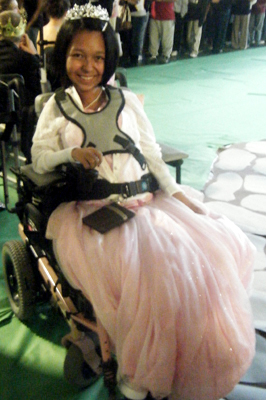
Though she's the features editor of the Lynnwood High School Royal Gazette, '08 Scholar, Yomara Bedolla will have to find someone else to write the feature story about homecoming this year since she will be too busy with her duties as queen. Yomara was coronated as Homecoming Queen at a school assembly on Monday, September 28, 2009, and reigned over the Homecoming football game on Friday, October 2. Way to go, Yomara!
What's Showing on YouTube?
Captioned videos! The University of Washington is in the process of captioning its videos that are posted to its YouTube channel. On its channel, you can watch videos from DO-IT, the Burke Museum, The Daily (the University's newspaper), UW's Athletic programs, the medical school, and much more.
Working on the team that is captioning the videos has taught me about the technology used to make video content accessible to more people.
Be sure to check out the new DO-IT Scholar and Ambassador video profiles at www.uw.edu/doit/videos/
Applying to Graduate School
So, you've decided that you want to continue your education after your undergraduate degree! You are in for quite a ride! Applying to graduate school is an expensive and time-consuming process. Before you apply, think carefully about the schools you are interested in and only apply to those that you can truly see yourself attending. The average application fee is around $60; if you apply to five schools at that rate, you will have paid $300! Many schools do not waive the fee during the application process at the graduate level. This is why you should only apply to schools that you feel are a good fit.
When I applied to graduate schools, I had to be strategic to finish all of my applications. Here are a few tips to get you on the right path:
- Create a timeline of application deadlines.
- Make a list of each school and what they want you to send (transcripts, writing samples, etc).
- Note how many letters of recommendation the schools you are interested in require.
- Note the method of submission (if you are to send in the materials by mail or submit them electronically).
Much like applying to college for an undergraduate degree, every school has different requirements, so pay attention to them. Your timeline and list of schools will be helpful in tracking all of the details.
Two important pieces to any graduate school application are your statement of purpose and curriculum vitae (C.V.).
A statement of purpose is the foundation for most applications. A strong statement of purpose can be just what you need to bump up your application if your grades or GRE (Graduate Record Examination, a standardized test required for some graduate schools) scores are not as high as you would like. Graduate schools are looking for passionate students who will care about what they learn, not necessarily the highest achievers, and your statement of purpose is the place to talk about this. Your C.V. is an academic resume that many schools ask for. I applied to gender studies and disability studies programs—they all wanted a copy of my C.V. When I was writing my C.V., I looked at examples from professors and current graduate students. Tailor your C.V. to your experience. For example, I included my education and work information, but I also had sections for scholarships, teaching experience, and publications, as those were things I had experienced and could highlight. If you were in clubs or volunteered while in college, include that information as well.
Many application deadlines are in December and January. It is a good idea to begin the whole process in September to give yourself plenty of time to collect all the materials you need and fill out all of the applications. Notify the people from whom you would like references early in the process. When I emailed three contacts asking if they would be willing to write me letters, I included my C.V. and a table of the schools I was applying to. In this table of schools, I included:
- the school, type of program, application deadline
- what form the letters were supposed to take (e.g. hard copy sent in by mail or electronic form)
- program website
- what I wanted the recommender to highlight in the letter (this is a good idea because every school has different requirements!)
I applied to two schools out of the country (one in the United Kingdom and one in Canada). This process was similar to applying to schools in the United States, but there were a few key differences. Each country has a different education system and you have to look at their guides to compare what your grades are with what they require. Additionally, if you are accepted into a school in a different country, you must apply for a visa to study there and will probably need to go through a different process to obtain financial aid. Check your school's website or call the admissions office for more information!
The graduate school process is hard but rewarding. I applied to seven schools and was accepted by three. This is a very high number to get accepted to! Don't be discouraged if you only get into one—that is quite an accomplishment! Graduate school is competitive and even if you are qualified for a program, you will only get chosen if the school feels you are a good fit for their program.
So, good luck in your application process. It will be worth all of the work in the end if you decide that graduate school is the right path for you.
Staff Profile
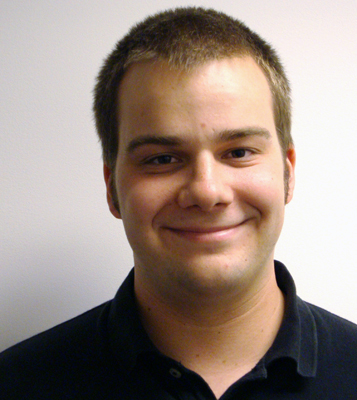
Hi, my name is Brian and I am a program assistant at DO-IT. I work on a number of different projects and offer support to the rest of the staff as needed. I have been working at DO-IT for the last year and a half, and I absolutely love it! I began working here while I was a student at the University of Washington.
I graduated from the UW in June 2009, with a Bachelor of Arts in English and a minor in music. During my four years of college, I performed with the UW Husky Marching Band, as a member of the drum line. I performed with the band at every home football game and select away games. I played drum set for UW volleyball and basketball games, including during NCAA tournament appearances by both teams. Through the marching band, I had an instant community of 240 friends, which really helped make the university seem small and welcoming to me.
One of the best classes that I took was the education course, "Why Do Some Students Do Better Than Others in School?" This class really opened my eyes to the many different challenges that students of all abilities face while attending school, from kindergarten right up through a college education. The class also allowed me to examine the challenges that I faced throughout my education, and how every student has the ability to overcome these barriers and receive an education that will work with and accommodate them.
When I am away from the office, I love to watch sports, particularly baseball and football at both the amateur and professional levels. I also volunteer as an umpire for little league baseball games, most recently for Northeast Seattle Little League. I have a deep appreciation for a wide variety of music and movies. Last summer, I traveled to Beijing and Shanghai, China, as a member of the 2008 Olympic Orchestra. In January 2010, I will be attending a professional baseball umpire academy in Kissimmee, Florida.
Tech Tips: An Accessible Smart Phone
Apple's iPhone VoiceOver is an application that provides access for blind and low vision users to Apple's OS X operating system and their iPhone and iPod touch devices. A sighted user sees application icons located in a grid on the iPhone's screen, and then taps with one finger on the desired application and it opens. Once open, the user taps on the various buttons specific to the application and reads the text, using a finger flicking gesture to scroll up and down to view more text. When more than one screen contains icons for applications, a sighted user would use a one-finger flick gesture to page left or right to show those other screens. Note that this flick gesture mentioned throughout this article is one in which your finger touches the touch-screen, drags across the surface, and then lifts off of it quickly.
VoiceOver can be activated by the user who is blind if his or her iPhone is connected to a screen reader enabled computer with iTunes running, otherwise it would require a sighted user to turn it on manually via the phone by doing the following steps:
- Tap the Settings icon.
- Tap on the General choice within Settings.
- Scroll down to Accessibility and tap on the VoiceOver category.
- Tap on the on/off switch for VoiceOver.
You'll then hear the iPhone speak via VoiceOver. Once enabled, interacting with the iPhone changes from what the sighted-user expects.
Key flick and tap gestures used with the iPhone:
- Flick Right = Move to next item
- Flick Left = Move to previous item
- Flick Down = Move to next item using rotor setting
- Flick Up = Move to previous item using rotor setting
- Three finger flick down = Scroll up one page
- Three finger flick up = scroll down one page
- Three finger double tap = toggle speech on/off
- Two finger double tap = Start and stop the current action
- Double tap = Activate or open the selected item
- Tap = Speak item
- Two finger flick up = Read all text from top of screen
- Two finger flick down = Read all text from current location downward
- Three finger triple tap = Turn screen curtain [privacy] off/on
With VoiceOver active, you can explore your iPhone by moving your finger around the screen. As you hover over an icon or control, you will hear a click sound followed by the name of that icon or control. Alternatively, you can flick left or right to jump to the next/prior icon or control. Flicking downward will read one character at a time the name of the highlighted application icon.
To open an application, double-tap an application icon or hold one finger on the icon and simultaneously tap with another finger elsewhere on the screen. Once the application is open, tap in various places on the screen to find buttons unique to the application, or flick left/right to toggle through available buttons. To page through screens that require scrolling, use three fingers to flick forward and back between pages.
Another controlling gesture is called the Rotor. This is done with two fingers both touching the screen and pivoting as if turning a knob clockwise or counter-clockwise. Doing this gesture in the mode where application icons are showing on the screen will toggle back and forth between two verbosity choices, words or characters. Once set, the up/down flick gesture will read one character/word at a time.
The VoiceOver speaking rate can be changed within the VoiceOver settings area by scrolling down to the Speaking Rate area and moving the slider. A single finger flick up when this is selected will increase the speaking rate. Single flicking down will decrease the speaking rate.
Limitations to Accessibility
Just as poorly designed webpages can be inaccessible if web authors don't label images with alternate text, poorly designed iPhone applications, or apps, can have similar problems. Following are a few examples.
The Weather app that ships with the iPhone presents the weather using graphic symbols that are familiar to sighted users, such as bright glowing suns and dark clouds with lightning bolts. However, this app does a great job of providing this same information to people without sight. Each tap or flick causes VoiceOver to read meaningful information, such as "Tuesday rain, high 63 degrees Fahrenheit, low 50 degrees Fahrenheit" (typical Seattle forecast).
Similarly, the KOMO TV news app, a local Seattle news source, is highly accessible. When you tap on a headline VoiceOver reads it aloud. If you double-tap the article it opens. Single taps on a paragraph reads aloud that entire paragraph. If this or another application uses italicized text however, VoiceOver fails to read that text.
In contrast, the New York Times app isn't designed to read back the article headlines nor does it enable the user to choose an article. Double-tapping doesn't bring up that article but instead, refreshes the list of articles in the application, leaving these articles unavailable to the person using VoiceOver.
One of the biggest barriers to iPhone users with visual impairments is typing. The iPhone has no physical keyboard for keystroke entries; instead it has an on-screen keyboard that appears when the user has entered a mode requiring characters to be entered. When VoiceOver is enabled, the interface acts similarly to how it deals with icons. Tapping on a keyboard character echoes back that character. Double-tapping on the same tiny target inputs that keystroke into the active application. This can be a challenge to do accurately as the on-screen keys are tiny and located close to each other, even in the landscape tilted orientation where they are spaced further apart. Fortunately there is an alternative keystroke entry method. With one finger on the desired key that you hear read aloud, you can hold that down and tap elsewhere on the screen with another finger to make that keystroke selection. The user can also do right/left flick gestures to move through the various on-screen keyboard characters when that is active. However, this can be a time-consuming way to type.
Privacy can also be a problem for VoiceOver users. For example, when entering a password on a desktop or laptop computer, screen reader software typically reads aloud only "asterisk, asterisk, asterisk" rather than the characters you're typing. This way, if someone else is listening as you type, they won't hear your password. Unfortunately the iPhone doesn't work this way. All characters are echoed as you type them, so in order to have similar privacy as what is found on a desktop or laptop computer, an iPhone user should make use of headphones so that someone else cannot overhear the password characters.
VoiceOver is capable of accessing email accounts that the phone can access. Single taps will reveal the folders in the account or the key information in the summary view of individual email messages. Double-taps will open a message; single taps will read stand-alone sentences or paragraphs.
There are thousands of applications available through the Apple App Store, and each of these can contain a number of buttons and controls. Keeping track of all these controls and remembering where they're located on the screen and how to access them my moving your fingers requires a bit of cognitive overhead.
Summary
The iPhone with VoiceOver enabled provides a great deal of access for users who are blind, not only to phone and messaging functions, but also to a variety of Internet-based applications. However, just as poorly designed websites can be difficult or impossible to navigate if the user utilizes a screen reader, poorly designed iPhone apps can prove to be equally limiting.
The on-screen keyboard does not come close to the input capacity of an external keyboard. If at some time, a user could connect an external keyboard via Bluetooth it would be much easier for both the sighted user and the user who is blind to do large scale input into iPhone applications. One clip-on mini-keyboard is due to be released in November of this year and may increase the ease of input for users who are blind as well as for sighted users.
The Thread: Practicing Problem Solving
Fall is here, many of you are back in school again, and I wanted to share with you a question posed by a DO-IT Ambassador in our Internet discussion forum and some of the responses, so that you can get the flavor of the many rich conversations the DO-IT community has online.
Should students be expected to take long examinations in one sitting? A few days ago, I took an accounting examination in the disability resource center that was forty-seven questions long. After about three hours, I started losing my concentration and reached the point where I could not complete the examination. Should I be expected to take long tests in one sitting? What are your viewpoints on this?
DO-IT Ambassador: I think you should be given as many sittings as other students. So if they get only one sitting you should too. More than one could give you an unfair advantage. But perhaps you need to look into why the test is taking you that long.
DO-IT Ambassador (posted original question): The main reason my examinations take so long is that in accounting my examinations usually require me to perform calculations. The tests contain a lot of multiple-choice questions. I use my portable PC to do the calculations. It's equipped with both Excel and Windows Calculator. For a multi-step problem I like to use Excel to perform the calculations for two reasons: (1) It allows me to check my work and see what steps I have already taken. (2) I can edit my formulas and reduce the chances that I will have to start the problem all over again.
Even with all those features, all too frequently, my calculations don't match the answers I have to choose from. Sometimes, it takes me several tries to determine where I am making my mistake.
DO-IT Mentor: How much time did the other students get for the exam? How long do you think it would have taken you to complete the test? It seems that the fact that your answers don't match the choices is not a disability-related problem, but one that every student could run into. Traditionally, a common reasonable accommodation is for the student with a disability to be given twice the amount of time the other students get. If you need even more time than that, you might reconsider whether you are using the most efficient method.
DO-IT Mentor: The fundamental question you have to ask and answer is whether or not you're taking longer on the test is a direct result of your disAbility and is something that can be reasonably accommodated. You'd want to prove that your accommodation is resolving a problem created by your disAbility and is not artificially compensating for a lack of knowledge to answer the questions.
The second thought I had was on test taking strategies. Sometimes with multiple choice tests, it is not necessary to work out every answer down to the last digit. Often, by estimating, looking at orders of magnitude, or the units that answers are presented in, the answer can be found without completing all of the calculations. If the professor is presenting some questions in multiple choice format rather than asking you to show your work and present all of the steps of your calculations, they may be expecting you to use more general knowledge of accounting to determine the correct answer. It might be helpful to discuss this with the professor or the TA [teaching assistant] and get some advice on test taking strategies.
DO-IT Mentor: I get time-and-a-half to take my tests, and I'm considering asking for double time because I have difficulties with both coordination and severe test anxiety. I personally don't like the idea of breaking the test up into two pieces because it's too tempting to take a peek at notes during the interim—an unfair advantage (and cheating, which is not cool!). That said, I take breaks during my tests, especially the long ones! At [my school], we're allowed to take our tests to the proctor or disability resource services (DRS) staff person and take breaks. This break time does NOT go on our test time. For me, breaks are a must because I get so worked up that either my head will explode or I'll have a nervous breakdown and start crying... neither situation would be pretty! :) I take a break and eat something in the DRS office or talk to one of the DRS people for a while; then, when I feel better, it's back to work.
On the other hand, you bring up a good point about fatigue. I'd probably go take a nap in DRS or in the lounge near DRS, but many people are not as informal as I am. Thoughts???
DO-IT Ambassador: In college I have never had to take breaks. However, in taking the SAT Reasoning Test, I was able to take breaks as part of the accommodations. I'm not sure if it transfers over to college, but it should be allowed if it is an appropriate accommodation.
DO-IT Mentor: One possible solution to the problem of the student having a chance to look at notes between test sessions would be to plan ahead of time that the test would be given in two parts. Then the student would only be given half of the questions at each test session. Do you think a professor [would] agree to that kind of an arrangement?
DO-IT Ambassador: I think that would depend a lot on the makeup of the exam. Sometimes one question offers clues to other questions. Thinking back, I believe I would have had a difficult time convincing professors that an exam needed to be taken over two periods. There just seems like too much opportunity to have a second cram session. I am not saying anyone would do that; we're all honest and responsible people. However, it is my opinion that the less suspicious situations one can be in the better.
DO-IT Ambassador: As far as calculations go, if your problem is related to using the calculator, you could ask the person proctoring the test to help you. I recently took a math test in the DRS office, and the test proctor typed into the calculator what I told her to, and then she read off the answer for me to write on the test.
DO-IT Ambassador (posted original question): I think the main problem is keeping track of the steps I have taken during calculations. This is why I never ask the person proctoring the examination to enter information into a calculator for me. There are several advantages to using a program like Excel or Windows Calculator:
- I can more easily keep track of information, especially when using Excel. I can look at the last calculations I did and find out what I need to do next.
- I can write down the numbers as the proctor is reading them to me. This is faster than having the proctor read the test several times and trying to remember what to tell him to enter. Even with programs like Windows Calculator or Excel, I still lose track of information. This is what slows me down during examinations.
DO-IT Mentor: Perhaps you can arrange to take a five-minute break every hour or a ten-minute break every two hours before you take your next long exam.
Also, have you been able to determine the main reason you are unable to get an answer that matches one of the choices? For example, are you making typographical errors when entering the numbers or formulas? Or are you making a thinking error when first deciding how to approach the problem? Knowing the reason for the mistakes might help you figure out how to prevent them.
DO-IT Ambassador (posted original question): I have not completely determined what is keeping me from getting an answer that matches the options on the examination. However, I have a few theories:
It could be a problem working with formulas. Another part of the problem could be with the order of operations. Part of the problem could also be drowsiness. If I spend too much time working on an examination, I start getting drowsy and have trouble concentrating on what I'm doing.
DO-IT Mentor: One thought would be to sit down with a TA and go over your problem solving process. That would help you identify where exactly the issue is coming from. That would probably help you determine the solution.
DO-IT Mentor: There aren't many people on the planet that can concentrate for more than three hours straight without losing concentration—whether at work or in tests. In those situations I find it works best to periodically take thirty-second breaks. Put down the pencil (or step away from the computer), focus on taking deep breaths, and do some stretches. You can determine what works best for you. Also, begin to monitor yourself, to know when your lack of concentration is crossing a line where you become less effective, then addressing that.
Sometimes people think this kind of technique slows them down too much to get the work done. Maybe it does for some, but for me it actually makes the rest of my time much more efficient. School teaches a lot more than just literal knowledge; it also forces someone to learn more practical skills. That's not to say there aren't disAbilities that make this kind of long testing difficult and thus very justifiably accommodated.
Key flick and tap gestures used with the iPhone:
- Flick Right = Move to next item
- Flick Left = Move to previous item
- Flick Down = Move to next item using rotor setting
- Flick Up = Move to previous item using rotor setting
- Three finger flick down = Scroll up one page
- Three finger flick up = scroll down one page
- Three finger double tap = toggle speech on/off
- Two finger double tap = Start and stop the current action
- Double tap = Activate or open the selected item
- Tap = Speak item
- Two finger flick up = Read all text from top of screen
- Two finger flick down = Read all text from current location downward
- Three finger triple tap = Turn screen curtain [privacy] off/on
How Can You DO-IT?
- Sign up to receive DO-IT News if this newsletter was not mailed directly to you.
- Volunteer as a Mentor or to help with one of our Summer Study programs.
- Pass this newsletter on to someone you know who can benefit from our programs.
- Donate money to support and extend DO-IT activities including sponsoring Scholars from states outside of Washington, special events, work-based learning experiences, participant attendant or travel costs, refreshments for program participants, and creation and distribution of educational videotapes and publications.
DO-IT today by completing the form below! You may also make a secure online credit card donation at the University of Washington Make a Gift page by selecting the "DO-IT Program Gift Fund" option.
___ Sign me up to receive copies of DO-IT NEWS, a free program newsletter.
___ Send me more information about DO-IT volunteer opportunities.
___ I would like to make a donation (payable to the University of Washington, Federal ID#91-6001537) to support DO-IT operations.
___ I have enclosed a check for $____________
___ Please charge $____________ to my credit card.
___ VISA ___ Mastercard
Date _____________
Card Number __________________________ Expiration Date _____________
Card Holder Name ___________________________________________________
Signature _____________________________________________________
Address ____________________________________________________________
City __________________________ State _____________ Zip ____________
Phone: Home __________________________ Business ____________________
E-mail: ____________________________________________________________
Your gift is tax-deductible as specified in IRS regulations. Pursuant to RCW 19.09, the University of Washington is registered as a charitable organization with the Secretary of State, State of Washington. For more information, call the Office of the Secretary of State, 1-800-322-4483.
Mail to:
DO-IT
University of Washington
Box 354842
Seattle, WA 98195-4842
Thank you!
More About DO-IT
DO-IT News is published at the University of Washington with input from DO-IT staff, Pals, Scholars, Ambassadors, and Mentors. DO-IT is primarily funded by the National Science Foundation, the U.S. Department of Education, and the State of Washington.
DO-IT (Disabilities, Opportunities, Internetworking, and Technology) serves to increase the successful participation of individuals with disabilities in challenging academic programs such as those in science, engineering, mathematics, and technology. Primary funding for DO-IT is provided by the National Science Foundation, the State of Washington, and the U.S. Department of Education. DO-IT is a collaboration of UW Information Technology and the Colleges of Engineering and Education at the University of Washington.
Grants and gifts fund DO-IT publications, videos, and programs to support the academic and career success of people with disabilities. Contribute today by sending a check to DO-IT, Box 354842, University of Washington, Seattle, WA 98195-4842.
Your gift is tax deductible as specified in IRS regulations. Pursuant to RCW 19.09, the University of Washington is registered as a charitable organization with the Secretary of State, state of Washington. For more information call the Office of the Secretary of State, 1-800-322-4483.
To order free publications or newsletters use the DO-IT Publications Order Form; to order videos and training materials use the Videos, Books and Comprehensive Training Materials Order Form.
For further information, to be placed on the DO-IT mailing list, request materials in an alternate format, or to make comments or suggestions about DO-IT publications or web pages contact:
DO-IT
University of Washington
Box 354842
Seattle, WA 98195-4842
doit@uw.edu
www.uw.edu/doit
206-685-DOIT (3648) (voice/TTY)
888-972-DOIT (3648) (voice/TTY)
206-221-4171 (fax)
509-328-9331 (voice/TTY) Spokane
Founder and Director: Sheryl Burgstahler, Ph.D.